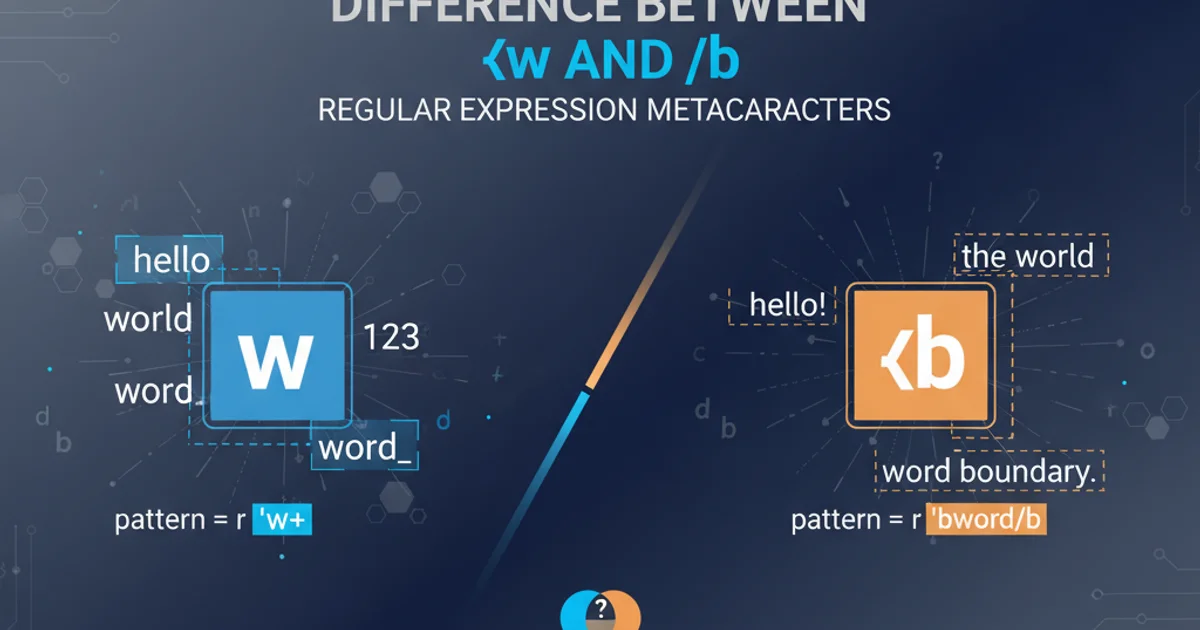Difference between \w and \b regular expression meta characters
Categories:
Understanding \w vs. \b in Regular Expressions

Explore the fundamental differences between the \w (word character) and \b (word boundary) metacharacters in regular expressions, and learn how to use them effectively for precise pattern matching.
Regular expressions are powerful tools for pattern matching in text. Among the many metacharacters available, \w and \b are frequently used but often confused. While both relate to 'words', they serve distinct purposes: \w matches a single word character, whereas \b matches a position that signifies a word boundary. Understanding this distinction is crucial for writing accurate and efficient regex patterns.
The \w Metacharacter: Matching Word Characters
The \w metacharacter stands for a 'word' character. It's a shorthand for the character class [a-zA-Z0-9_]. This means it will match any uppercase letter, any lowercase letter, any digit, or an underscore. It's important to note that \w matches a single character at a time, not an entire word. To match multiple word characters, you would typically combine \w with quantifiers like + (one or more) or * (zero or more).
Pattern: \w
Text: hello_world123!
Matches: h, e, l, l, o, _, w, o, r, l, d, 1, 2, 3
Example of \w matching individual word characters.
Pattern: \w+
Text: hello_world123!
Matches: hello_world123
Example of \w+ matching a sequence of word characters (a 'word').
\w's definition of a 'word character' is often locale-dependent in some regex engines. For instance, in some environments, it might include Unicode word characters, while in others, it strictly adheres to [a-zA-Z0-9_].The \b Metacharacter: Matching Word Boundaries
In contrast to \w, the \b metacharacter does not match any character. Instead, it matches a position. Specifically, it matches a position where one side is a 'word' character (\w) and the other side is a 'non-word' character (\W, which is anything not matched by \w), or the beginning/end of the string. Think of \b as an invisible anchor that marks the start or end of a word. This is incredibly useful for matching whole words and avoiding partial matches.
Pattern: \bcat\b
Text: The cat sat on the concatenate.
Matches: cat (only the standalone word 'cat')
Example of \b ensuring a full word match.
Pattern: cat
Text: The cat sat on the concatenate.
Matches: cat (in 'cat'), cat (in 'concatenate')
Without \b, 'cat' matches within 'concatenate'.
graph TD
A[Start of String/Non-Word Char] --> B("\b (Word Boundary)")
B --> C[Word Character (\w)]
C --> D[... (More Word Chars)]
D --> E("\b (Word Boundary)")
E --> F[End of String/Non-Word Char]
style B fill:#f9f,stroke:#333,stroke-width:2px
style E fill:#f9f,stroke:#333,stroke-width:2px
style C fill:#ccf,stroke:#333,stroke-width:2px
style D fill:#ccf,stroke:#333,stroke-width:2pxVisualizing the concept of a word boundary (\b) in relation to word characters (\w).
Key Differences and Use Cases
The core difference lies in what they match: \w matches characters, while \b matches positions. This distinction dictates their primary use cases:
- Use
\wwhen you need to match individual characters that are part of a word, or when you want to define what constitutes a 'word' in your pattern (e.g.,\w+to match an entire word). - Use
\bwhen you need to match whole words and ensure that your pattern doesn't accidentally match parts of other words. It's essential for precise word-level searching and replacement.
\b with patterns that might contain non-word characters. For example, \bfoo-bar\b might not work as expected if the hyphen is considered a non-word character, as \b would match before and after the hyphen.Let's look at a practical comparison:
Text: 'apple pie, pineapple, apply'
Pattern: `pie`
Matches: 'pie' (in 'apple pie'), 'pie' (in 'pineapple')
Pattern: `\bpie\b`
Matches: 'pie' (only in 'apple pie')
Pattern: `\w`
Matches: a, p, p, l, e, p, i, e, p, i, n, e, a, p, p, l, e, a, p, p, l, y
Pattern: `\w+`
Matches: apple, pie, pineapple, apply
Comparison of pie, \bpie\b, \w, and \w+.